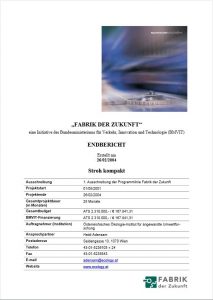 Straw as building material has been in use for a long time, for example to build walls or as insulant. A process rendering straw applicable, in particular, for prefabricated wall- and roof components has been developed in a research project. Project results show that straw is not merely a cost-efficient and ecologically sensible building material; it also meets essential requirements for insulants. Due to its excellent thermal insulation properties, straw can also be applied in passive houses. In order to avoid mildew growth and varmint affection, wall components are filled with bale straw in the carpentry and the prefabricated parts are assembled on site.
Straw as building material has been in use for a long time, for example to build walls or as insulant. A process rendering straw applicable, in particular, for prefabricated wall- and roof components has been developed in a research project. Project results show that straw is not merely a cost-efficient and ecologically sensible building material; it also meets essential requirements for insulants. Due to its excellent thermal insulation properties, straw can also be applied in passive houses. In order to avoid mildew growth and varmint affection, wall components are filled with bale straw in the carpentry and the prefabricated parts are assembled on site.
During the research project, four different building constructions were insulated with straw: two new buildings and two building restoration projects. A bale straw serial wall was developed and used for external walls and roof elements in a new passive house building construction in Perchtoldsdorf; the entire façade and
flat roof of a newly constructed single family home in Thal near Graz were furnished with bale straw. The south-east wall of the extension to an existing single family home in Vienna-Oberlaa was realised as straw-insulated prefabricated wall. In the redevelopment of a house in Nestelbach near Graz, the entire roof structure and façade of the old building were insulated with bale straw.
Preliminary examinations effected during the research project indicate that registration of small size bale straw insulants on EC-level is feasible. Four businesses have already been indicated as potential licence owners who would like to realise the licensing process.
The certification of bale straw insulants is presently being prepared. Certified straw bales will meet the following properties and quality criteria:
- Bale size: length: 60 to 90 cm, width: 46 to 50 cm, height: 36 to 40 cm;
- Gross density: upper and lower limit: 80 kg/m3 to 90 kg/m3;
- Straw moisture content: < 15 %;
- Pest plant growth: < 0.5 wt. %;
- Residual grain ratio: < 0.4 wt. %;
- Thermal conductivity: λD (23/50) = 0.046;
- Fire behaviour: B2;
- Flow resistance: 0.43 kPa s/m2
- Water absorption: 4.3 kg/m2
- Settlement within the component: max. 2.3 %;
- Resistance against the impact of biologic agents: class 3.
Calculated simulations effected during the project indicate that, although straw is a comparatively favourable medium for mould growth, small bale straw insulants applied under proper workmanship in the investigated wall constructions are safe from fungal
attack and, thus, protected from health-hazardous MVOC-emissions.
In order to meet the required quality properties at competitive prices, further product development regarding achievable bale densities and the fabrication of small bales from large and round bales will be required. Further research is indicated, in particular, regarding hygrothermal conditions at various component junctions and co-operation potentials in marketing and supply of bale straw insulants.
Project Leader: Heidi Adensam, Österreichisches Ökologie-Institut für angewandte Umweltforschung
Partner: AGRAR PLUS Beteiligungs Ges.m.b.H, Holzbau Unfried GmbH, ConsultS, Haus der Baubiologie, Österreichisches Institut für Baubiologie und -ökologie
Date: Vienna, February 2004
Program: „FABRIK DER ZUKUNFT“ eine Initiative des Bundesministeriums für Verkehr, Innovation und Technologie (BMVIT).
READ MORE
Merken
Merken
Merken
Merken
Merken
Merken
Merken
Merken
 Straw as building material has been in use for a long time, for example to build walls or as insulant. A process rendering straw applicable, in particular, for prefabricated wall- and roof components has been developed in a research project. Project results show that straw is not merely a cost-efficient and ecologically sensible building material; it also meets essential requirements for insulants. Due to its excellent thermal insulation properties, straw can also be applied in passive houses. In order to avoid mildew growth and varmint affection, wall components are filled with bale straw in the carpentry and the prefabricated parts are assembled on site.
Straw as building material has been in use for a long time, for example to build walls or as insulant. A process rendering straw applicable, in particular, for prefabricated wall- and roof components has been developed in a research project. Project results show that straw is not merely a cost-efficient and ecologically sensible building material; it also meets essential requirements for insulants. Due to its excellent thermal insulation properties, straw can also be applied in passive houses. In order to avoid mildew growth and varmint affection, wall components are filled with bale straw in the carpentry and the prefabricated parts are assembled on site.






